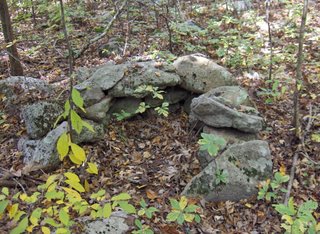 Here is a picture of Bob Miner, the owner. His grandfather noticed these things and always wondered about them.
Here is a picture of Bob Miner, the owner. His grandfather noticed these things and always wondered about them.  He especially wondered about several miniature stone chambers (first reported here by Norman Muller) perhaps big enough for a single person. There were three of them as well as a "U" of similar dimensions. These little chambers face south west and Bruce said one faced directly towards the winter solstice sunset.
He especially wondered about several miniature stone chambers (first reported here by Norman Muller) perhaps big enough for a single person. There were three of them as well as a "U" of similar dimensions. These little chambers face south west and Bruce said one faced directly towards the winter solstice sunset. 
 Here is the third, video'ed:
Here is the third, video'ed:There was also a more familiar structure: a stone U facing east or northeast.
 In addition to these enclosures and U's and short rows of stones, there were some interesting shapes which I'll put in the next post.In addition there were a number of effigy-like rock and rock piles, as I'll describe next.
In addition to these enclosures and U's and short rows of stones, there were some interesting shapes which I'll put in the next post.In addition there were a number of effigy-like rock and rock piles, as I'll describe next.
No comments :
Post a Comment